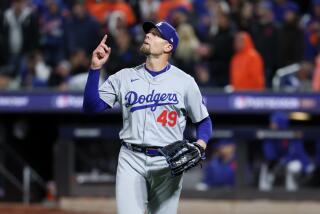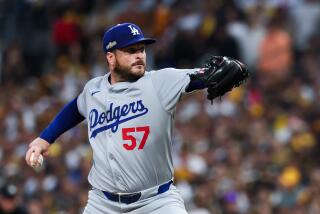Braves’ Bullpen Is a New Relief
ATLANTA — They’re an odd collection: the Cy Young starter-turned-closer, the guy who took 2 1/2 years off, the 28-year-old rookie.
Eclectic, yes, but effective, too, by joining forces to give the Atlanta Braves the most dominating bullpen in baseball.
“There’s no doubt there’s been a couple of surprises,” starting pitcher Kevin Millwood said. “Not surprised that they could get people out, but surprised how well they’ve done collectively. I don’t remember anybody having a pen that’s been as good as consistently as these guys have been all year.”
The Braves usually end things with John Smoltz, the 1996 Cy Young winner who spent his first 13 seasons as a starter. He switched to closer midway through last season when his right elbow couldn’t stand the strain of working six or seven innings at a time.
But Smoltz is merely a good place to start when talking about the long, strange road this bullpen has traveled. Consider his cohorts:
* Chris Hammond, who retired midway through the 1998 season and spent the next 2 1/2 years helping raise his three children on an Alabama ranch. He returned to the game last year and now, at age 36, has never been better.
* Kevin Gryboski, who spent seven years toiling in the Seattle farm system without ever getting a call to the majors. In January, he was picked up by the Braves in an obscure minor-league deal and finally made it to the majors at age 28.
* Mike Remlinger, another late bloomer who had mediocre stints with San Francisco, the New York Mets and Cincinnati. Acquired by the Braves after the ’98 season as a throw-in to the Denny Neagle-for-Bret Boone trade, he suddenly blossomed into one of the most effective setup relievers in the game.
* Darren Holmes, a former closer in Colorado whose career appeared to be over after he pitched for three organizations in 2000 and missed all of last season recovering from back surgery.
* Kerry Ligtenberg, who was spotted by the Braves while pitching in the now-defunct Prairie League. The team gave up six dozen baseballs and two dozen bats to sign him.
Cumulatively, Atlanta’s bullpen was 16-9 with 26 saves through Wednesday and led the majors with an earned-run average of 2.37 as the All-Star break approached, helping the Braves build a commanding lead in the NL East.
“I’m not going to say it’s our biggest surprise, but it’s definitely the biggest asset of our team,” starter Jason Marquis said. “I didn’t think Hammond or Holmes would come back after such a long hiatus, but they’ve proven they can pitch.”
Hammond believes experience is the key to a successful bullpen. Excluding Gryboski, the other five relievers have a total of more than 40 years in the big leagues.
“I’d have to say everybody besides (Gryboski) has pitched in situations that nobody wants to pitch in,” Hammond said. “I guess the pressure doesn’t bother anybody in our bullpen.”
It doesn’t bother Gryboski, either. After spending so much time in the minors, the prospect of facing someone such as Mike Piazza with the game on the line doesn’t seem overwhelming.
“I always knew I could pitch at this level,” Gryboski said. “I just wanted an opportunity, a chance to show what I could do.”
The right-handed Gryboski, who began his pro career in 1995, never got a call from the Mariners even though he put up strong numbers at double A and triple A. He had 43 saves in the last three years, including a career-high 22 at Tacoma last season.
When the Braves spotted Gryboski on the waiver wire in the offseason, they contacted the Mariners and worked out a trade.
“They wouldn’t give me a chance at all,” Gryboski said, adding that Mariners Manager Lou Piniella “wanted veteran pitchers with experience. I kind of got lost in the mix.”
The rest of the Braves’ pitching staff wonders how someone with Gryboski’s stuff managed to get overlooked. He has a devastating sinker that’s just as effective to left-handed hitters as it is to right-handers.
In his first 21 games with the Braves, Gryboski was 2-1 with a 1.44 ERA, working his way into a setup role.
“He’s probably got the best stuff of anybody down there,” said starter Greg Maddux, no small statement in a bullpen that also includes Smoltz. “He’s got the best pitch in baseball: the moving fastball that he can locate.”
Hammond might just be a bigger surprise than Gryboski. After all, the left-hander thought his career was over when he headed home in 1998 rather than report to the minors. He didn’t even pick up a baseball for more than two years.
After calling off retirement, Hammond spent the entire 2001 season at triple A, then was invited to spring training by the Braves as a non-roster player. He made the team and quickly earned an important role out of the bullpen, going 6-2 with a 1.59 ERA in his first 30 games.
Smoltz, who usually pitches in save situations (he had converted 25 of 28 chances), is the only reliever with a definite role. Manager Bobby Cox feels so comfortable with the others that he mixes and matches freely. Remlinger and Hammond are left-handers. Gryboski and Holmes are righties. All have worked in setup roles.
“If we had just one or two guys, it would be a tough situation,” Holmes said. “But Bobby has six guys (including another rookie, Tim Spooneybarger) he can use before Smoltzie. He has confidence in all of us.”
Atlanta’s bullpen has been a liability in some playoff appearances. If the Braves go on to win their 11th consecutive division title, they won’t mind placing a call to this group of relievers.
“I don’t think our bullpen has ever been anywhere close to where this one is,” Millwood said. “Those guys have bonded together and everybody out there accepts their role.”
More to Read
Go beyond the scoreboard
Get the latest on L.A.'s teams in the daily Sports Report newsletter.
You may occasionally receive promotional content from the Los Angeles Times.










